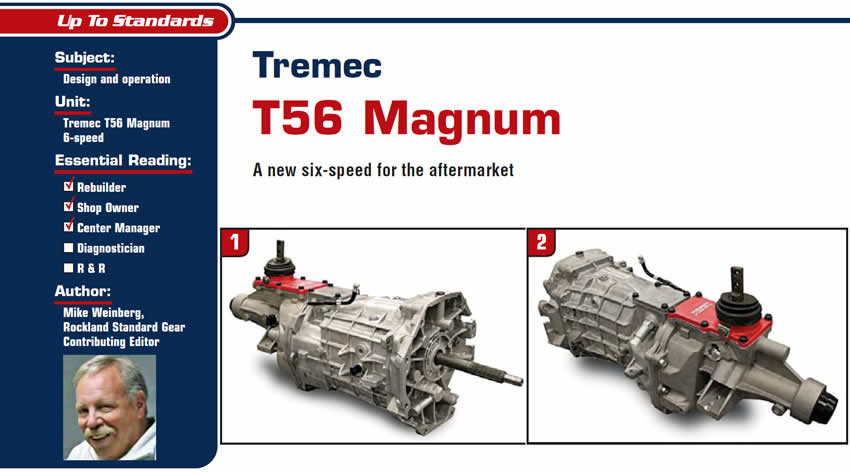
Up To Standards
- Subject: Design and operation
- Unit: Tremec T56 Magnum 6-speed
- Essential Reading: Shop Owner, Center Manager, Rebuilder, Diagnostician, R&R
- Author: Mike Weinberg, Rockland Standard Gear, Contributing Editor
A new six-speed for the aftermarket
BorgWarner designed and manufactured the T56 six-speed transmission, which is the premier six-speed on the market today. BorgWarner sold its stick-shift-transmission line to Tremec, and Tremec has continued to manufacture and refine the T56 design.
The T56 is original equipment on the Chevrolet Camaro, Pontiac Firebird and GTO, Chevrolet C5 and C6 Corvettes, Mustang GT, Cadillac CTSV, Dodge Viper, Dodge Sidewinder truck and Aston Martin. The unit is rated at 450 lb.-ft. of torque and was updated by Tremec to carbon-fiber synchro rings for very smooth shifts. New products from the car manufacturers over the years have increased horsepower and torque ratings, and the T56 design needed an upgrade to handle more torque.
In 2005, Tremec introduced the 6060, a design variation of the T56, for the Ford Mustang. The face width of the gears was substantially increased to handle more power, but the case size remained the same. Tremec did this by redesigning the synchronizers. The slider and hub were narrowed, making room for the increased face width on the gears, and sintered-metal synchro rings were used. The synchronizer engagement teeth on the slider and the speed gears were redesigned for a positive stop and quicker shifting.
Tremec is now releasing a T56 six-speed gearbox for the aftermarket called the T56 Magnum (figures 1 and 2). This unit is based on the 6060 design with further improvements and the ability to be adapted to replace earlier T56 units for car owners who have increased their torque and horsepower beyond the stock T56 levels. The T56 Magnum will handle 700 lb.-ft. of torque, almost double the stock T56 capacity. Models will be available for replacement of all the earlier T56 models as well as new designs that will enable you to install the transmissions into any vehicle equipped with a small- or big-block Chevy engine, or a 4.6- or 5.0-liter or Windsor Ford engine. In this economy, these units will be one more added service you can bring to your performance-minded customers. There always seems to be money for the toys.
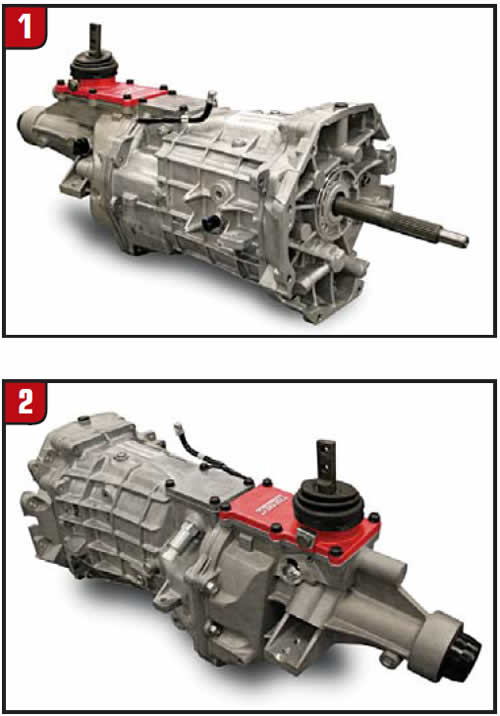
The specs for the T56 Magnum follow:
- Centerline distance – 85 millimeters (the distance between the center of the input shaft and the center of the countershaft)
- Torque capacity – 700 lb.-ft.
- Weight – 130 lbs.
- Fluid fill – 3.65 quarts of Dexron 3 ATF or GM Synchromesh fluid
- Dual speedometer pickups allow use of this unit with either mechanical or electronic speedometers.
- Triple-cone synchronizer technology on gears 1-4; double-cone synchronizers on 5th, 6th and reverse.
- High-rpm shift capacity
- Fully reversible shifter to allow changing position of the shift lever in the car simply by reversing the shift cover.
- Built-in mid-shift provisions under the inspection plate for simple forward placement of the shifter for earlier cars with bench seats.
Gear design
The T56 Magnum uses the 6060 gear design. The face widths of the gears (Figure 3) have been significantly widened to handle more torque. The original-design T56 speed gears were one-piece forgings that were subject to machining limitations because of the lead angles of the gears and the shaping of the engagement teeth. The Magnum gears are forged, with the plate containing the engagement teeth laser-beam welded to each gear. This enables much more precise shaping of the engagement teeth with better pitch and angle control and the placement of a positive stop on the gear to prevent over-travel of the slider on hard shifts.
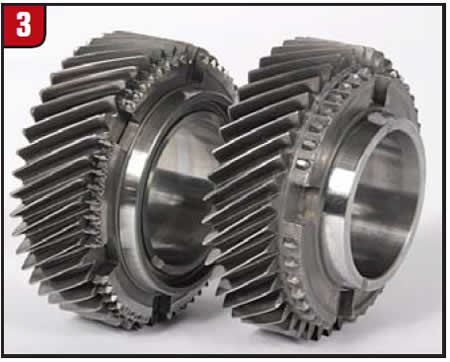
Countershaft
Earlier T56 designs used a two-piece countershaft that was torque limited because of the splines connecting the two sections. The one-piece shaft was first used in the Dodge Viper. The Magnum model uses a much-stronger one-piece shaft with thicker journals and widened gear faces. Larger bearings are used in all the support areas to zero out shift deflection and live through the increased thrust loads. A look at Figure 4 gives you a feel for the much-beefier new design.
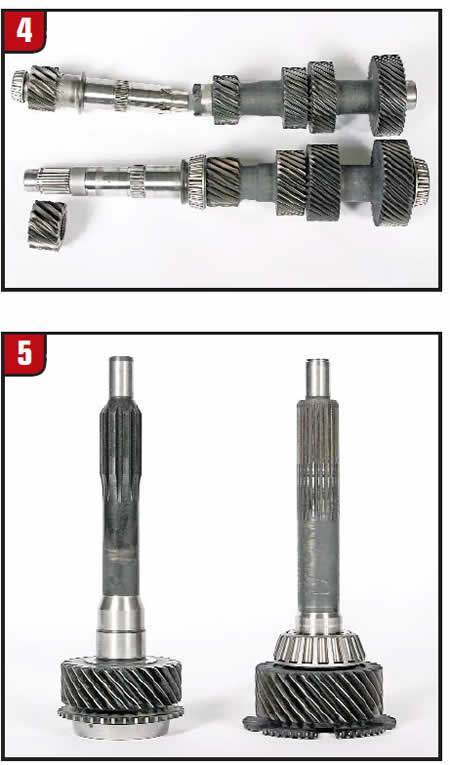
Input shaft
The input shaft (Figure 5) has a larger face width on the gear and increased shaft diameter. Clutch splines are lengthened to enable use of twin-disc clutches, and there are 26 clutch splines for added strength. For better handling of higher thrust loads the input bearing is upgraded to a larger size.
Synchronizers
The widened gear train called for narrower synchronizers (figures 6, 7 and 8). The engagement-tooth angles were changed on the slider to shorten engagement travel and further smooth out the shifts. Earlier designs used stamped-steel shift keys with circular retaining springs. As heat and wear changed spring tension it was common for the keys to break, trapping the slider in a gear. We have for years replaced the stamped keys with solid billet keys on performance units. Tremec has changed the design to spring-loaded ball-type inserts to reduce friction and prevent notchy shifting. This results in very short, smooth shifts.
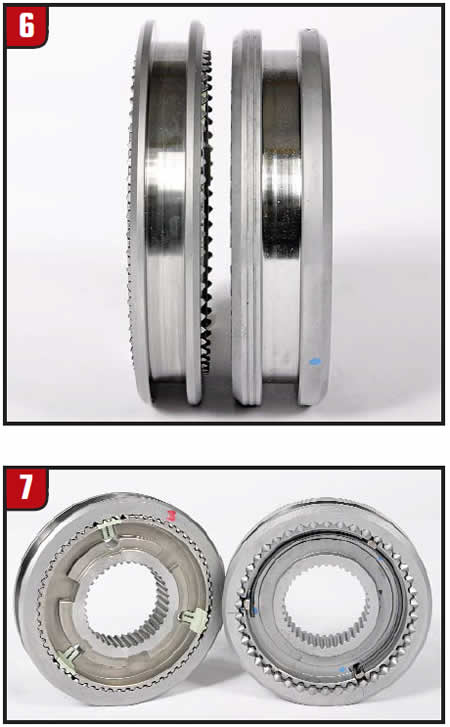

Shift forks
One of the design flaws of the T56 was the cast-aluminum forks with a removable steel shift link (Figure 9). As wear and tear occurred the steel link would wear into the aluminum, creating a float in the fork that resulted in incomplete shifts and gear jump-out. The new shift fork, at the rear of Figure 9, has the shift link permanently mounted in the fork so there is no contact with the rail bore in the fork for precision shifting and reduction of fork wear. The new forks also have an enhanced cross section for better rigidity and zero deflection.
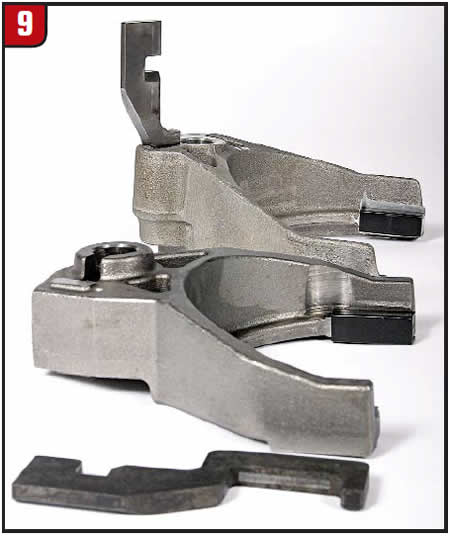
Snap rings
One of the weak points in any high-torque-load transmission is the snap rings (Figure 10). It is hard to keep the snap rings in perfect dimensions, and distortion of the shaft grooves during machining and service work results in snap rings jumping out of the groove, with usually expensive results. The Magnum units have been redesigned using split-ring technology. The rings are held in place by an outside sleeve that prevents any movement or possibility of the retainer leaving the shaft groove.
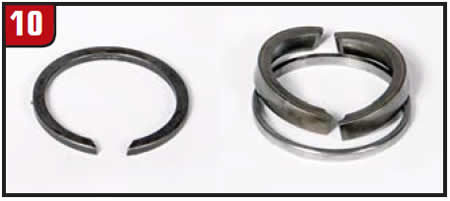
The transmission case has been beefed up with added webbing and thicker front and rear faces to handle the increased thrust load of high-horsepower usage. The front plate also has been strengthened to accept the bigger input-shaft bearing. Figure 11 shows all applications and the specifications and ratios.
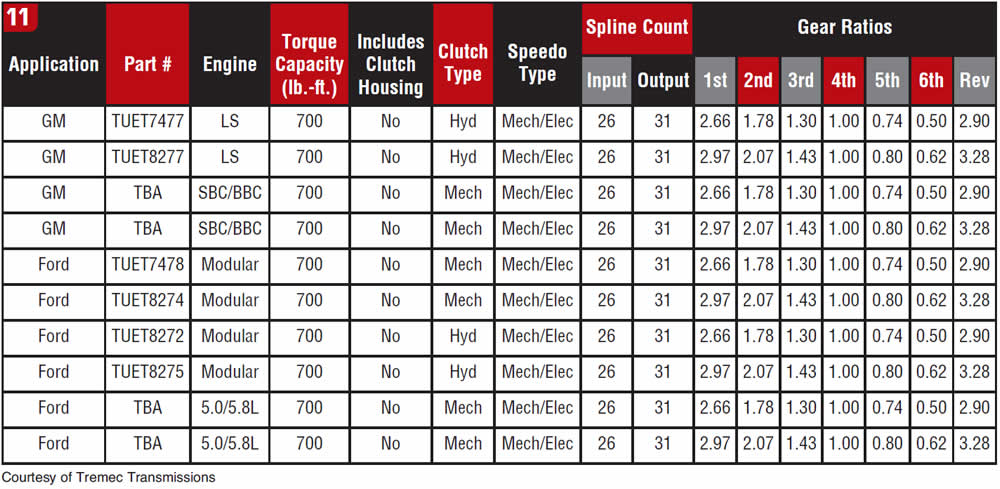
This new design will make it possible for you to get into the high-dollar performance aftermarket with no investment. All the difficult engineering has been done for you. The transmission-mounting and clutch setups remain the same, two options exist for speedometer application, a common 31-spline yoke fits all units, and you can tailor the shifter position from stock to forward or offset to allow installation in cars never before equipped with a six-speed. There are two overdrive gears for easy cruising in cars with hot cams or numerically high-ratio rear ends. The object here is to find a niche market in your area to bring in dollars instead of just waiting for the phone to ring.














